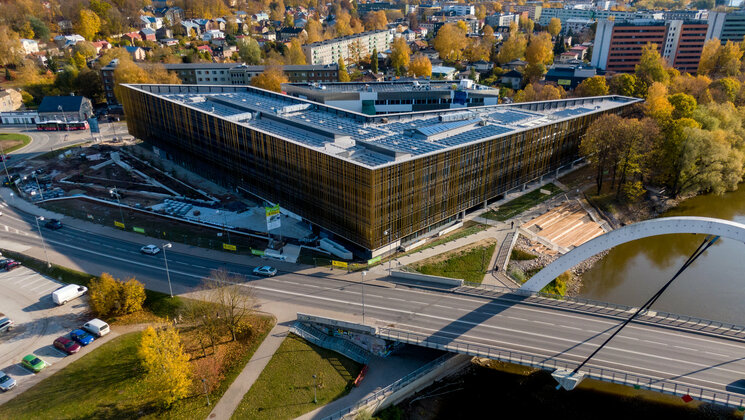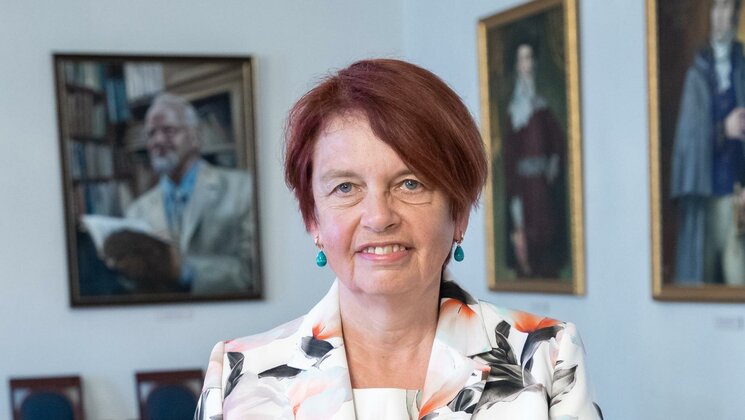-
Faculty of Arts and HumanitiesDean's Office, Faculty of Arts and HumanitiesJakobi 2, r 116-121 51005 Tartu linn, Tartu linn, Tartumaa EST0Institute of History and ArchaeologyJakobi 2 51005 Tartu linn, Tartu linn, Tartumaa EST0Institute of Estonian and General LinguisticsJakobi 2, IV korrus 51005 Tartu linn, Tartu linn, Tartumaa EST0Institute of Philosophy and SemioticsJakobi 2, III korrus, ruumid 302-337 51005 Tartu linn, Tartu linn, Tartumaa EST0Institute of Cultural ResearchÜlikooli 16 51003 Tartu linn, Tartu linn, Tartumaa EST0Institute of Foreign Languages and CulturesLossi 3 51003 Tartu linn, Tartu linn, Tartumaa EST0School of Theology and Religious StudiesÜlikooli 18 50090 Tartu linn, Tartu linn, Tartumaa EST0Viljandi Culture AcademyPosti 1 71004 Viljandi linn, Viljandimaa EST0Professors emeriti, Faculty of Arts and Humanities0Associate Professors emeriti, Faculty of Arts and Humanities0Faculty of Social SciencesDean's Office, Faculty of Social SciencesLossi 36 51003 Tartu linn, Tartu linn, Tartumaa EST0Institute of EducationJakobi 5 51005 Tartu linn, Tartu linn, Tartumaa EST0Johan Skytte Institute of Political StudiesLossi 36, ruum 301 51003 Tartu linn, Tartu linn, Tartumaa EST0School of Economics and Business AdministrationNarva mnt 18 51009 Tartu linn, Tartu linn, Tartumaa EST0Institute of PsychologyNäituse 2 50409 Tartu linn, Tartu linn, Tartumaa EST0School of LawNäituse 20 - 324 50409 Tartu linn, Tartu linn, Tartumaa EST0Institute of Social StudiesLossi 36 51003 Tartu linn, Tartu linn, Tartumaa EST0Narva CollegeRaekoja plats 2 20307 Narva linn, Ida-Virumaa EST0Pärnu CollegeRingi 35 80012 Pärnu linn, Pärnu linn, Pärnumaa EST0Professors emeriti, Faculty of Social Sciences0Associate Professors emeriti, Faculty of Social Sciences0Faculty of MedicineDean's Office, Faculty of MedicineRavila 19 50411 Tartu linn, Tartu linn, Tartumaa ESTInstitute of Biomedicine and Translational MedicineBiomeedikum, Ravila 19 50411 Tartu linn, Tartu linn, Tartumaa ESTInstitute of PharmacyNooruse 1 50411 Tartu linn, Tartu linn, Tartumaa ESTInstitute of DentistryL. Puusepa 1a 50406 Tartu linn, Tartu linn, Tartumaa ESTInstitute of Clinical MedicineL. Puusepa 8 50406 Tartu linn, Tartu linn, Tartumaa ESTInstitute of Family Medicine and Public HealthRavila 19 50411 Tartu linn, Tartu linn, Tartumaa ESTInstitute of Sport Sciences and PhysiotherapyUjula 4 51008 Tartu linn, Tartu linn, Tartumaa ESTProfessors emeriti, Faculty of Medicine0Associate Professors emeriti, Faculty of Medicine0Faculty of Science and TechnologyDean's Office, Faculty of Science and TechnologyVanemuise 46 - 208 51003 Tartu linn, Tartu linn, Tartumaa ESTInstitute of Computer ScienceNarva mnt 18 51009 Tartu linn, Tartu linn, Tartumaa ESTInstitute of GenomicsRiia 23b/2 51010 Tartu linn, Tartu linn, Tartumaa ESTEstonian Marine Institute0Institute of PhysicsInstitute of ChemistryRavila 14a 50411 Tartu linn, Tartu linn, Tartumaa EST0Institute of Mathematics and StatisticsNarva mnt 18 51009 Tartu linn, Tartu linn, Tartumaa EST0Institute of Molecular and Cell BiologyRiia 23, 23b - 134 51010 Tartu linn, Tartu linn, Tartumaa ESTTartu ObservatoryObservatooriumi 1 61602 Tõravere alevik, Nõo vald, Tartumaa EST0Institute of TechnologyNooruse 1 50411 Tartu linn, Tartu linn, Tartumaa ESTInstitute of Ecology and Earth SciencesJ. Liivi tn 2 50409 Tartu linn, Tartu linn, Tartumaa ESTProfessors emeriti, Faculty of Science and Technology0Associate Professors emeriti, Faculty of Science and Technology0Institute of BioengineeringArea of Academic SecretaryHuman Resources OfficeUppsala 6, Lossi 36 51003 Tartu linn, Tartu linn, Tartumaa EST0Area of Head of FinanceFinance Office0Area of Director of AdministrationInformation Technology Office0Administrative OfficeÜlikooli 17 (III korrus) 51005 Tartu linn, Tartu linn, Tartumaa EST0Estates Office0Marketing and Communication OfficeÜlikooli 18, ruumid 102, 104, 209, 210 50090 Tartu linn, Tartu linn, Tartumaa EST0Area of Vice Rector for DevelopmentCentre for Entrepreneurship and InnovationNarva mnt 18 51009 Tartu linn, Tartu linn, Tartumaa EST0University of Tartu Natural History Museum and Botanical GardenVanemuise 46 51003 Tartu linn, Tartu linn, Tartumaa EST0International Cooperation and Protocol Office0University of Tartu MuseumLossi 25 51003 Tartu linn, Tartu linn, Tartumaa EST0Area of RectorRector's Strategy OfficeInternal Audit OfficeArea of Vice Rector for Academic AffairsOffice of Academic Affairs0University of Tartu Youth AcademyUppsala 10 51003 Tartu linn, Tartu linn, Tartumaa EST0Student Union OfficeÜlikooli 18b 51005 Tartu linn, Tartu linn, Tartumaa EST0Centre for Learning and TeachingArea of Vice Rector for ResearchUniversity of Tartu LibraryW. Struve 1 50091 Tartu linn, Tartu linn, Tartumaa EST0Grant Office
Estonian researchers want to improve survival of bone marrow cancer patients
Multiple myeloma (MM) is a neoplastic disease of bone marrow and accounts for approximately 13% of all hematologic cancers. In Estonia the survival of MM is only 30 months whereas in the US it is considerably higher. This difference is mainly explained by different access to anti-myeloma agents in the US and Europe. On 9 September, experts of the subject from Estonia, the US and elsewhere will meet at the University of Tartu to discuss the latest developments of the disease and increase research cooperation with the US to improve the survival of MM patients in Estonia.
University of Tartu Associate Professor of Haematology Edward Laane described that the annual age-adjusted incidence of MM is 5.6 per 100 000 in Western countries and the median age at diagnosis is close to 70 years.
Since the introduction of melphalan and prednisone in 1969, the treatment of MM for most patients was unchanged for 30 years with a median survival of 2–3 years. Survival was improved to 3–4 years with multi-agent chemotherapy induction followed by autologous transplantation.
“Since 1999, with new agents in the MM treatment, the average survival rate has improved considerably exceeding more than five years in selected centres. However, improved survival is seen mostly in the US population,” said Laane.
He gave the example that according to the US SEER population database, the survival of five years of MM was 46.6% in 2005–2011 and in EU only 39.6% in 2006–2008. “In Estonia, the median survival of MM in 2005–2009 was only 30 months and the survival of five years was only 33% in 2010–2014. This difference is mainly explained by different access to anti-myeloma agents in the US, Europe and Estonia. The situation in Estonia is very worrying,” said the associate professor.
According to Professor Kenneth Anderson, the head of the MM programme at Dana-Farber Cancer Insitute, the world’s leading MM research and treatment centre located in the US, the median survival of MM can exceed eight years.
The seminar “Multiple Myeloma 2016—State of The Art” on 9 September at 12–17 at the UT assembly hall includes leading researchers of the field from the UT, incl. Professor Hele Everaus, and also leading experts from the Dana-Farber Cancer Institute. The seminar is opened by UT Vice Rector for Academic Affairs Mart Noorma.
One of the leading researchers of MM, Professor Nikhil Munshi, is coming to Tartu. By applying the latest technology, he has revealed that the immune system and genetic instability play a major role in the pathogenesis and disease progression of MM. Professor Munshi’s research group has published numerous publications on myeloma immunobiology and genetics.
According to Edward Laane, the aim of the seminar is to promote scientific cooperation between the Dana-Farber Cancer Institute and the University of Tartu. “The direct benefit to the University of Tartu Haematology-Oncology Clinic is collaborative research with the top US cancer research centre, which in turn is aimed to improve the survival on MM patients in Estonia,” said Laane and added that this collaboration could also give young researchers of the University of Tartu the opportunity to visit the Dana-Farber Cancer Institute.
This programme is implemented with funding from the Baltic-American Freedom Foundation. More information about BAFF scholarships and research scholars is available on the BAFF website.
Additional information
Edward Laane, UT Associate Professor of Haematology
+372 53976332
edward.laane@ut.ee
Mobile: +372 5815 5392
Read more similar news






